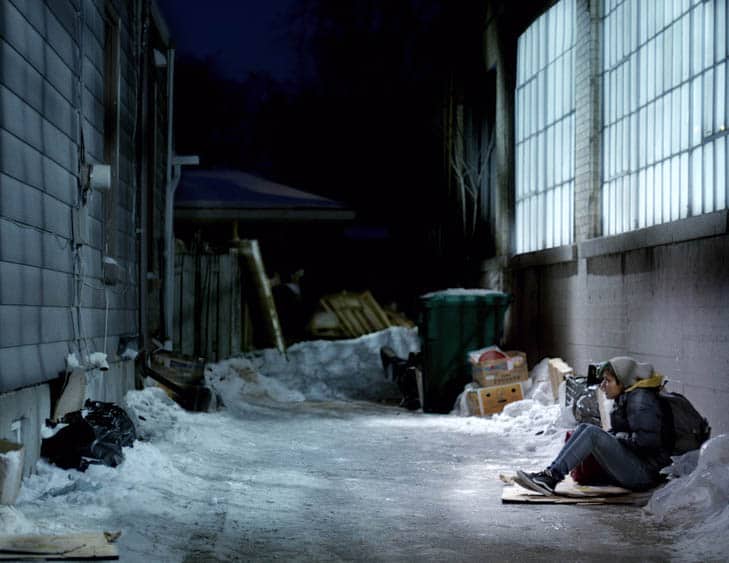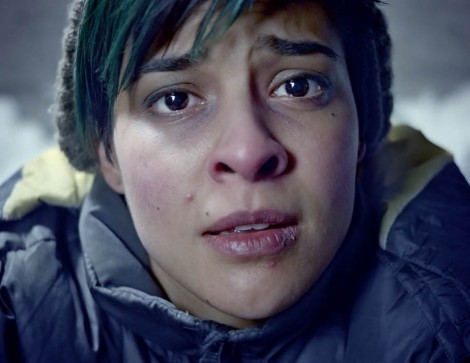On Saturday May 30, dusk is falling in David Pecaut Square, just west of the financial district. People wander in and out, carrying backpacks, sleeping bags, and blankets. Tents with board games and other activities are set up near a main stage, and pink-shirted volunteers are about to offer their support.
The square is set up like a campground, looking out of place in the urban surroundings. The rain and steadily dropping temperature suggest that the crowd would be better off gathering indoors.
Yet the wet weather does little to dampen the spirits of those gathered. In support of a cause close to their hearts, a cohort of spirited individuals has volunteered to give up their warm beds for a night outside.
The event, “OUT at Night”, is hosted by Egale Canadian Human Rights Trust and aims to tackle Lesbian, Gay, Bi, Transgender, Queer, 2-spirit (LGBTQ2S, Egale’s version of the LGBTQ+ acronym) youth homelessness.
To Egale, this issue is a crisis requiring a national-level response strategy. Through OUT at Night, the long-standing advocacy group asks participants to subject themselves to just one aspect of what over 6,000 LGBTQ2S youth endure in Canada every year, hoping to raise awareness — and funds — for their cause.
The Toronto event, one of 44 hosted across the country, featured a series of programs in the form of speaker sessions and performances. The evening’s MC was drag king Tyler Uptight, who introduced acts and individual speakers. Special guests included Toronto Chief of Police Mark Saunders — a strong supporter of Egale’s initiatives — and former Canadian competition swimmer Mark Tewksbury, famous for winning a gold medal in the 1992 Summer Olympics. Tewksbury, who identifies as gay, has been a spokesman for the community for several years.
Also on the program was Ill Nana DiverseCity Dance Company, a Toronto queer and multiracial organization dedicated to dance and self-expression, as well as LGBTQ2S advocacy. Dancers, Sze-Yang, Ade-Lam, and Jelani Ade-Lam were joined by Toronto singer-songwriter, Shadrach Kabango, and delivered a compelling performance.
Egale hopes that this event can put what is often a neglected issue into a more prominent place in the public consciousness.
The neglected problem
“This issue can no longer be denied. Our youth can no longer be silenced and ignored,” says Dr. Alex Abramovich, a U of T alumnus, CAMH fellow, and researcher for the government of Alberta. Abramovich’s work focuses on LGBTQ2S homelessness and risk, and he argues for policies that directly address the particular set of circumstances faced by homeless LGBTQ2S youth.
It’s plain to see why Egale refers to LGBTQ2S homelessness as a crisis. Twenty-one per cent of youth living on the streets identify as LGBTQ2S, and 20 per cent of the LGBTQ2S youth who are kicked out of their homes end up living on the street. These youth are often further victimized and are at higher risk of developing health and drug-related problems.
The extent of this problem in Toronto is likely far greater. Homeless individuals often migrate to the city, and at levels that are not always picked up by survey staff. “For example,” continued Abramovich, “many youth choose to not come out as queer or trans to volunteers conducting the survey, for a variety of reasons that often stem from issues regarding safety; and countless LGBTQ youth did not have a chance to complete the survey because they are part of Toronto’s hidden homeless population and do not access services, due to issues regarding homophobia and transphobia in the shelter system and drop-in programs.”
Moreover, as Abramovich and others point out, health and drug-related issues often coincide with homelessness, especially among LGBTQ2S youth. Stress resulting from homelessness and compounded by discrimination contributes to depression and high rates of suicide.
Dr. Shelly Craig, a social worker and University of Toronto professor who focuses on sexual minority youth programs, agrees that young people who identify as LGBTQ2S face a plethora of stress factors, which puts them at increased risk.
“LGBTQ youth experience the typical daily stress of any adolescent as well as the stress of repeated discrimination such as hearing a homophobic or transphobic slur or being assumed to be heterosexual or cisgender,” noted Craig, adding that “…this stress wears them down. For many youth, there are also violent physical attacks or rejections [that they are faced with].”
Craig’s research found that over 80 per cent of LGBTQ2S youth reported symptoms of depression and anxiety, and many attributed this to the stress of being marginalized. This explanation, she argues, is consistent with what she calls “minority stress theory,” which proposes that individuals from marginalized populations experience a unique form of stress, “due to conflict between their internal sense of self and their experiences of majority social norms and expectations.”
Craig sees that while some queer and trans-focused services have been established — such as crisis lines and support groups — awareness and access to these services are limited, and do not necessarily address poverty or health risks.
Eric Cashmore has experienced this problem first hand. He now works in youth outreach and education at the Durham AIDS Centre. Cashmore was homeless when he lost his job, contracting HIV as a victim of assault, and developed a drug addiction. He lived on the streets until the Durham AIDS Centre hired him in November 2014.
Cashmore describes his process of mental and physical health treatment, addiction recovery, and desperate attempts to access services as typical of the LGBTQ2S homeless experience. “Social services saved my life,” he said.
Throughout his own struggles, Cashmore spent his time on the streets helping others navigate social services, namely the Ontario Disability Support Program. To get coverage for mental and physical illnesses, applicants must go through assessments, rejections, and tribunals. For homeless people, all of this communication and notification is conducted via caseworkers that, in many cases, have at best a tenuous connection with the applicants.
Cashmore explains that it’s a difficult and ruthlessly bureaucratic process, exacerbated in no small part by issues of marginalization, mental illness, youth, and inexperience. “The system is broken from the very beginning, from the very front lines,” he says.
The way forward
Egale is acutely aware of the issues posed by a broken system. The organization has long been involved in efforts to rectify the LGBTQ2S homelessness problem. One significant stride was made in March of this year, when the Toronto City Council approved funding for two LGBTQ2S youth transitional housing programs, one of which will be run by Egale. The other will be operated through the YMCA, and is scheduled to open this summer.
Though news like this is a welcome start, the broader issue of LGBTQ2S youth homelessness needs to be addressed at all levels of government, argues Cashmore. For those living on the streets, as Cashmore was until last year, service access is unpredictable at best, and downright inaccessible at worst. In February, the Ministry of Community and Social Services rolled out an alternative program that resulted in seemingly random cancellations of coverage, bizarre or incorrect notifications, and misplaced cheques — with potentially disastrous results.
“This month, my drug card didn’t come in the mail. I called my caseworker and was told my file was closed,” said Cashmore, who had to contact an MPP to get it reopened. The file should never have been changed in the first place. Cashmore stresses though, that even his inconsistent coverage is more than many others in his situation are able to receive. “It’s a bureaucracy,” he said, with marked disdain and frustration in his voice.
Abramovich also suggested that public programs have a long way to go. He added that making essential policy changes wouldn’t necessarily translate to a change in attitudes on the ground. Both, he argued, are necessary for a sustainable solution.
“The findings of my research and other research in the area suggest that service providers offering support to homeless youth are not prepared to deal with homophobic and transphobic situations due to a lack of training, and in some circumstances, wilful ignorance,” he said. “Actors such as institutional erasure, homophobic and transphobic violence that is rarely dealt with, and discrimination make it difficult for LGBTQ youth to access shelters; therefore, a high proportion of queer and trans youth often feel safer on the streets than in shelters and support services.”
That this unsettling statement is a reality for thousands of Canadian youth is a call in its own right for a societal shift. Craig has found that stigma and discrimination are still pervasive at the ground level, even in spaces where rules are officially established to address them. “Stigma and discrimination are a daily challenge for LGBT people,” Craig argues. “It still persists and ranges from a micro-aggression, a word uttered on the street to physical assault and violence leading to death. There is still stigma because we allow it.”
The hope of initiatives like OUT at Night, is to push these conversations forward, into the public consciousness where they might have a broader impact.
Correction: An earlier version of this article incorrectly referred to Alex Abramovich.



